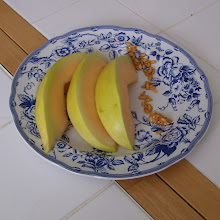C#-minor scale
Kreutzer Number 24
Ciaccona
My approach to Ciaccona week began with the "afraid to play it, so just won't practice at all" strategy. Now that the week is half over, I've decided to just enjoy playing the Ciaccona and being able to scratch out the notes, even if they aren't all played the same tempo and without stopping and scratching my head and being annoyed that my old teacher changed the bowings and fingerings, which just makes things more ambiguous.
I was amazed when I learned that there wasn't anything magical about playing the notes to an amazing piece of music, like the Ciaccona or the Tchaikovsky Violin Concerto. You don't have to be a perfect violinist to play those pieces and get a kick out of hearing the music you love coming out of your violin. It's a long stretch from playing them well, but there's something cool about it. I think it's better to experience them as an amateur than to say, "Oh, I can't play that," and never try. One can also argue that it's sacrilegious to play such special pieces badly or without putting in enough sweat. To each his own.
Wednesday, June 16, 2010
Friday, June 4, 2010
Week of May 30 2010
G-sharp Minor Scale
Kreutzer No. 22
D-minor partita: Sarabande
The Sarabande could be played on an accordion. The chords sound like they are breathing in and out. In the first measure, I can imagine the accordion pressing in one beat one and pulling out on beats two and three, or vice versa. Also, "wake up" quality of rolling of the bow from the G and D strings to the A and E strings on the first chord reminds me of the way accordions get suddenly loud when the player moves the bellows quickly.
The movement also sounds like something that would be played in a church, particularly at the end of the first section. The violinist holds out and open E and plays underneath it, ending on the five chord. It sounds like the happily ever after with God end of an organ piece.
Kreutzer No. 22
D-minor partita: Sarabande
The Sarabande could be played on an accordion. The chords sound like they are breathing in and out. In the first measure, I can imagine the accordion pressing in one beat one and pulling out on beats two and three, or vice versa. Also, "wake up" quality of rolling of the bow from the G and D strings to the A and E strings on the first chord reminds me of the way accordions get suddenly loud when the player moves the bellows quickly.
The movement also sounds like something that would be played in a church, particularly at the end of the first section. The violinist holds out and open E and plays underneath it, ending on the five chord. It sounds like the happily ever after with God end of an organ piece.
Subscribe to:
Comments (Atom)


